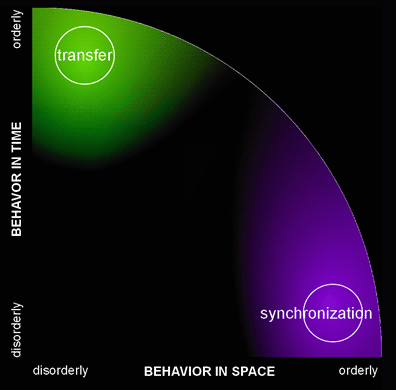
The principles of brain function remain an enduring mystery to human knowledge, though a number of important properties have been identified. For instance, there appears to be flows of activity that deploy spatially when the organism is stimulated by external “input” – and such flows also happen spontaneously when the organism is temporarily placed in relative isolation from its environment, e.g. during rest. These temporally ordered states of the brain co-exist with another aspect of organization –one that is expressed in space-, as when mutually-coupled neural ensembles engage in phase-synchronous activity. Spatial order meets the system’s need for collective behavior and mass action, whereas a degree of temporal order lends support to the travelling of information.
In their radical forms, those two properties of spatial and temporal order are paradoxical: if the system is synchronous, activity stagnates and precludes the existence of information flows. On the other hand, if a strict temporal order is created, the system may lack basic temporal coincidence that is required to witness synchronous activity. A unifying theory of these spatiotemporally ordered regimes of the brain is metastability. It is a principle of brain function that enrolls its neural ensembles into weak, transient, spatially and temporally changing aggregates. Key to this phenomenon is the weak coupling of the components, and/or disparities in their dynamical behavior, a sine-qua-none condition for the emergence of complexity.
Through this principle of metastability, the system achieves swift, transient and flexible creation of functional ensembles. A metastable theory is an encompassing and self-contained explanation of the brain's spatiotemporal organization: no superordinate mechanism is necessary to explain spontaneous changes of brain states, for instance those that are seen during endogenous activities such as thinking.
In the media
Simons Foundation Autism Research Initiative, March 11th, 2009: New EEG analysis captures coordination among brain regions.
Plexus Institute, February 9th, 2009. Observing the Human Brain at Work.
News Wise, January 19th, 2009. Groundbreaking Technique Reveals Modus Operandi of the Intact Living Brain.
To learn more
- Tognoli, E., Kelso, J.A.S. (in prep). The metastable brain. [abstract]
- Tognoli E., Kelso J.A.S. (2009). Brain Coordination Dynamics: True and False Faces of Phase Synchrony and Metastability. Progress in Neurobiology, 87(1): 31-40. [direct link] [abstract] [PDF]
- Kelso, J.A.S. , Tognoli, E. (2007). Toward a Complementary Neuroscience: Metastable Coordination Dynamics of the Brain. In R. Kozma & L. Perlovsky (Eds.) Neurodynamics of Higher-level Cognition and Consciousness. Springer, Heidelberg. [link] [direct link] [abstract] [PDF]. Reprinted in Murphy, N., Ellis, G. F. R., O'Connor, T. (2009). Downward Causation and the Neurobiology of Free Will. Springer, Heidelberg. [link] [direct link] [abstract] [PDF]
- Kelso, J.A.S., Tognoli, E. (2006). Metastability in the brain. Proceedings of the International Joint Conference on Neural Networks, Vancouver, pp.755-760. [direct link] [abstract] [PDF]
- Kelso, J.A.S., Tognoli, E. (2006). Metastability in the brain. IEEE World Conference on Computational Intelligence, Vancouver, Canada, July 16th-21st. [PPT]
- Kelso J.A.S. & Tognoli E. Spatiotemporal metastability: design for a brain. HBBL Meeting, January 27th 2011. [PPT]
- Tognoli, E., Kelso, J.A.S. (submitted). Enlarging the scope on brain coordination dynamics.
- Tognoli, E., J. A. S. Kelso (2011). A world of coordination: a journey across scales. Minisymposium in honor of Michael Turvey. Boca Raton, FL. [PPT]
- Tognoli, E., (2011). Spatiotemporal metastability & functional complexity. Clion 2011, University of Memphis. [PPT] [link]
- Tognoli, E. (2007). EEG Coordination Dynamics: self-organization in the brain. Merck and Co Laboratories, West-Point, USA, December 17th. [abstract] [PPT]
- Tognoli, E., Kelso, J.A.S. (2011). On the brain’s dynamical complexity: coupling and causal influences across spatiotemporal scales. In Advances in Cognitive Neurodynamics (III), eds. Y. Yamaguchi et al. Dordrecht: Springer Netherlands. [abstract] [PDF] [companion PPT]
- Bressler S.L., Tognoli, E. (2006). Operational principles in neurocognitive networks. International Journal of Psychophysiology, 60: 139-148. [abstract] [PDF]
- Tognoli E., (2011). Design for a brain: structure, dynamics & emerging functional complexity. FAU Department of Computer & Electrical Engineering and Computer Science, November 30th. [PPT]
- Tognoli, E., (2009). Coordination Dynamique du Cerveau & fonctions intégratives de l’esprit et du comportement humain. May 15, Strasbourg, by videoconference. [PPT]
- Tognoli, E. (2008). Zero-lag synchronization in neural populations: where are the strong evidences? Center for Complex Systems and Brain Sciences, February 1st. [PPT]
See also 'Brain Coordination Dynamics 2010: an international conference at sea'
|

